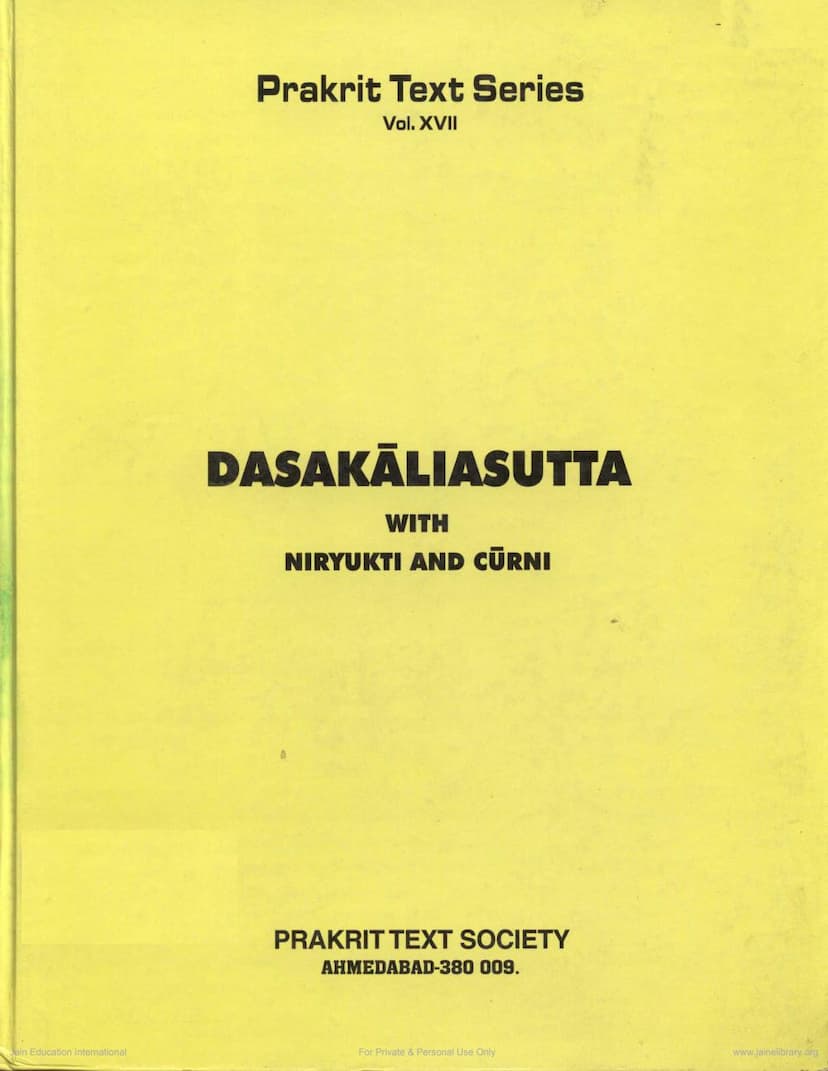Agam 42 Mool 03 Dashvaikalik Sutra
Added to library: September 1, 2025

Summary
This is a comprehensive summary of the Jain text "Agam 42 mool 03 Dashvaikalik Sutra" (also known as Dasakaliyasuttam), based on the provided catalog link and page excerpts.
Book Title: Agam 42 mool 03 Dashvaikalik Sutra (Dasakaliyasuttam) Author(s): Shayyambhavsuri, Bhadrabahuswami, Agstisingh, Punyavijay Publisher: Prakrit Granth Parishad / Prakrit Text Society Year: 2003 (Reprint)
Overall Summary:
The Dashavaikalik Sutra is a foundational text within the Jain Agamas, specifically belonging to the Shatkhanda (group of six) scriptures. This particular edition, compiled and edited by Muni Shri Punyavijayaji, is highly valued for including the original text, Bhadrabahu's (known as Bhadrabahu Swami) Niryukti (a metrical commentary), and Agastyasimha's (also known as Agastisingh) Churṇi (a detailed prose commentary). The presence of these commentaries, especially the previously unpublished Churṇi, makes this edition a significant contribution to Jain scholarly literature.
The text itself, Dasakaliyasuttam, is considered a primary scripture for monks, serving as an introductory text to the monastic way of life. It focuses on the conduct and ethics of Jain monks, outlining their daily practices, principles, and disciplines. The title "Dashakaliya" suggests it deals with ten essential aspects or periods of time relevant to monastic life.
Key Components and Contributions of this Edition:
-
Dasakaliyasuttam (The Core Text): The fundamental teachings of the sutra are presented. It details the ethical and practical guidelines for Jain monks, emphasizing principles like non-violence (ahimsa), self-control (samyama), and asceticism (tapas). The text elaborates on the proper conduct in various situations, the importance of ethical behavior, and the path to liberation.
-
Bhadrabahu's Niryukti: Bhadrabahu, a prominent Jain acharya and a key figure in the transmission of Jain Agamas, provided a metrical commentary (Niryukti) on the Dashakaliya Sutra. This Niryukti likely explains the verses and concepts in a concise, metrical format, aiding in the memorization and understanding of the original text.
-
Agastyasimha's Churṇi: This edition is particularly notable for including Agastyasimha's Churṇi, which was published for the first time. Churṇis are elaborate prose commentaries that delve deeply into the meaning of the Niryukti and the original sutra, providing detailed explanations, examples, etymological derivations, and philosophical discussions. Agastyasimha's work is highly regarded for its scholarly depth and is crucial for understanding the nuances of the text.
-
Editorial Work by Muni Punyavijayaji: The meticulous editing by Muni Punyavijayaji is highlighted. His dedication to reviving and publishing ancient Jain texts, including the Dashakaliya Sutra with its rare commentary, is recognized as a monumental contribution to preserving Jain heritage. The preface acknowledges his passing before the completion of the second reprint, with others finishing his work.
-
Structure and Content:
- Ten Studies (Dash Adhyayanas): The sutra is structured into ten main studies, each focusing on different aspects of monastic discipline.
- Chulikas (Appendices): Two appendices (Chulikas), Raivaka and Vivittachariya, are included, which the Niryukti describes as 'Uttar Tantra' (later treatise) that summarizes the essence of the sutra.
- Ethical Framework: The text elaborates on the five great vows (mahāvratas) and other essential disciplines for monks, such as right conduct, mindfulness, and detachment.
- Practical Guidance: It offers practical advice on daily life, including conduct towards living beings, alms-gathering (bhiksha), speech, and the proper use of utensils and possessions.
- Philosophical Underpinnings: While practical, the text also touches upon philosophical concepts like the nature of the soul (jiva), the non-soul (ajiva), karma, and the path to liberation.
- Examples and Narratives: The Churṇi, in particular, uses numerous anecdotes, stories, and analogies to illustrate the principles, making the teachings relatable and memorable.
- Scholarly Apparatus: The edition includes detailed introductions, explanations of abbreviations (e.g., manuscript sources), and a comparison of different manuscript readings, which are invaluable for scholars.
-
Historical and Linguistic Significance: The text is a significant source for understanding the development of Jain monasticism, its ethical standards, and the evolution of Jain literature and philosophy. The Prakrit language used in the text and commentaries provides insights into linguistic history.
-
Theological Importance: The Dashavaikalik Sutra is considered essential for aspiring monks and lays the groundwork for their spiritual journey. It emphasizes the cultivation of virtues and the avoidance of pitfalls on the path to omniscience and liberation.
Key Figures:
- Sayyambhavasuri (Shayyambhavsuri): Primarily credited with the Dashakaliya Sutra itself.
- Bhadrabahuswami (Bhadrabahu): Author of the Niryukti commentary.
- Agastyasimha (Agastyasinha): Author of the Churṇi commentary, unique to this edition.
- Muni Shri Punyavijayaji: The dedicated editor of this specific publication.
Overall Significance:
This edition of the Dashavaikalik Sutra, enriched by the Niryukti and the rare Churṇi of Agastyasimha, edited by Muni Punyavijayaji, is a vital resource for anyone seeking to study Jain monasticism, ethics, and philosophy. It provides deep insights into the disciplined life of Jain ascetics and the profound wisdom encapsulated in these ancient texts. The extensive editorial notes and critical apparatus further enhance its value for academic and personal study.